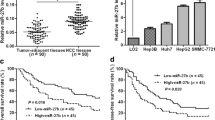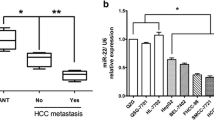Abstract
Objective
Increasing evidence shows that microRNA (miR) is related to drug resistance in hepatocellular carcinoma (HCC). miR-34b-5p could retard tumor development, but its function in HCC is still unclear.
Methods
miR-34b-5p expression was determined in HCC tissues and cell lines. Analysis and verification of the binding between miR-34b-5p and metadherin (MTDH) was carried out. The actual action of miR-34b-5p and MTDH in the area of proliferation, apoptosis, invasion, and migration of cisplatin (DDP)-resistant HCC cells was monitored.
Results
miR-34b-5p was downregulated in HCC. Overexpression of miR-34b-5p enhanced the sensitivity of HCC cells to DDP, inhibiting proliferation, migration, and invasion and promoting apoptosis. MTDH was the direct target of miR-34b-5p. MTDH was upregulated in HCC tissues, which was negatively correlated with miR-34b-5p expression. Enhancement of MTDH can reverse the effect of upregulated miR-34b-5p on the chemosensitivity of HCC cells.
Conclusion
miR-34b-5p targets MTDH and enhances the chemosensitivity of HCC cells.





Similar content being viewed by others
Data availability
Data are available from the corresponding author on request.
References
Au K, Chok K (2018) Multidisciplinary approach for post-liver transplant recurrence of hepatocellular carcinoma: a proposed management algorithm. World J Gastroenterol 24(45):5081–5094
Bilbao J et al (2018) Hepatocellular carcinoma treatment: ablation and arterial embolization. Radiologia 60(2):156–166
Chang Y et al (2007) Sorafenib (BAY 43-9006) inhibits tumor growth and vascularization and induces tumor apoptosis and hypoxia in RCC xenograft models. Cancer Chemother Pharmacol 59(5):561–574
Cucchetti A et al (2012) Current concepts in hepatic resection for hepatocellular carcinoma in cirrhotic patients. World J Gastroenterol 18(44):6398–6408
Dhiman G et al (2019) Metadherin: a therapeutic target in multiple cancers. Front Oncol 3(9):349
Dong L et al (2020) MiR-34b-5p inhibits cell proliferation, migration and invasion through targeting ARHGAP1 in breast cancer. Am J Transl Res 12(1):269–280
Fang L et al (2019) Treatment of primary hepatic carcinoma through ultrasound-guided microwave ablation. Niger J Clin Pract 22(10):1408–1411
Farazi P, DePinho R (2006) Hepatocellular carcinoma pathogenesis: from genes to environment. Nat Rev Cancer 6(9):674–687
Glassberg M et al (2019) Microwave ablation compared with hepatic resection for the treatment of hepatocellular carcinoma and liver metastases: a systematic review and meta-analysis. World J Surg Oncol 17(1):98
Guo R et al (2020a) Long non-coding RNA PRNCR1 modulates non-small cell lung cancer cell proliferation, apoptosis, migration, invasion, and EMT through PRNCR1/miR-126-5p/MTDH axis. Biosci Rep 40(7):BSR20193153
Guo X et al (2020b) Circular RNA circBFAR promotes the progression of pancreatic ductal adenocarcinoma via the miR-34b-5p/MET/Akt axis. Mol Cancer 19(1):83
Hsieh MJ et al (2020) Effects of miR-34b/miR-892a upregulation and inhibition of ABCB1/ABCB4 on melatonin-induced apoptosis in VCR-resistant oral cancer cells. Mol Ther Nucleic Acids 6(19):877–889
Hu J et al (2016) Double primary hepatic cancer (hepatocellular carcinoma and intrahepatic cholangiocarcinoma) originating from hepatic progenitor cell: a case report and review of the literature. World J Surg Oncol 14(1):218
Hu JH et al (2023) Cancer-associated fibroblast exosome LINC00355 promotes epithelial-mesenchymal transition and chemoresistance in colorectal cancer through the miR-34b-5p/CRKL axis. Cancer Gene Ther 31(2):259–272
Intaraprasong P, Siramolpiwat S, Vilaichone R (2016) Advances in management of hepatocellular carcinoma. Asian Pac J Cancer Prev 17(8):3697–3703
Jiang J et al (2017) Treatment of hepatocellular carcinoma with portal vein tumor thrombus: advances and challenges. Oncotarget 8(20):33911–33921
Khan M, Sarkar D (2021) The scope of astrocyte elevated gene-1/metadherin (AEG-1/MTDH) in cancer clinicopathology: A Review. Genes 12(2):308
Kumar M et al (2009) Dicer1 functions as a haploinsufficient tumor suppressor. Genes Dev 23(23):2700–2704
Lambertz I et al (2010) Monoallelic but not biallelic loss of Dicer1 promotes tumorigenesis in vivo. Cell Death Differ 17(4):633–641
Liu Z et al (2019) Overexpression of CASC2 improves cisplatin sensitivity in hepatocellular carcinoma through sponging. DNA Cell Biol 38(11):1366–1373
Liu C et al (2020) MicroRNA-497-5p functions as a modulator of apoptosis by regulating metadherin in ovarian cancer. Cell Transplant 29:963689719897061
Lu J et al (2005) MicroRNA expression profiles classify human cancers. Nature 435(7043):834–838
Luo G et al (2021) Exosomal LINC00355 derived from cancer-associated fibroblasts promotes bladder cancer cell resistance to cisplatin by regulating miR-34b-5p/ABCB1 axis. Acta Biochim Biophys Sin 53(5):558–566
Peng S et al (2009) Multi-class cancer classification through gene expression profiles: microRNA versus mRNA. J Genet Genomics 36(7):409–416
Qian C et al (2020) MYC-regulated lncRNA NEAT1 promotes B cell proliferation and lymphomagenesis via the miR-34b-5p-GLI1 pathway in diffuse large B-cell lymphoma. Cancer Cell Int 20:87
Schlachterman A et al (2015) Current and future treatments for hepatocellular carcinoma. World J Gastroenterol 21(28):8478–8491
Shi X, Wang X (2015) The role of MTDH/AEG-1 in the progression of cancer. Int J Clin Exp Med 8(4):4795–4807
Song M (2015) Hepatic artery infusion chemotherapy for advanced hepatocellular carcinoma. World J Gastroenterol 21(13):3843–3849
Steel J et al (2007) Preliminary results of an individually tailored psychosocial intervention for patients with advanced hepatobiliary carcinoma. J Psychosoc Oncol 25(3):19–42
Tian J et al (2020) LINC02418 promotes colon cancer progression by suppressing apoptosis via interaction with miR-34b-5p/BCL2 axis. Cancer Cell Int 20:460
Wang X et al (2021a) Effects of FER1L4-miR-106a-5p/miR-372-5p-E2F1 regulatory axis on drug resistance in liver cancer chemotherapy. Mol Ther Nucleic Acids 24:449–461
Wang Y, Lin C, Liu Y (2021b) Molecular mechanism of miR-34b-5p and RNA binding protein HuR binding to lncRNA OIP5-AS1 in colon cancer cells. Cancer Gene Ther 29(5):612–624
Wu S, Zhang T, Du J (2016) Ursolic acid sensitizes cisplatin-resistant HepG2/DDP cells to cisplatin via inhibiting Nrf2/ARE pathway. Drug Des Dev Ther 10:3471–3481
Yang L et al (2018) Efficient and tumor-specific knockdown of MTDH gene attenuates paclitaxel resistance of breast cancer cells both in vivo and in vitro. Breast Cancer Res 20(1):113
Yang C et al (2020) Inflammation and DNA methylation-dependent down-regulation of miR-34b-5p mediates c-MYC expression and CRL4 E3 ligase activity in colitis-associated cancer. Am J Pathol 190(3):674–688
Zhang M et al (2017) miR-217 suppresses proliferation, migration, and invasion promoting apoptosis via targeting MTDH in hepatocellular carcinoma. Oncol Rep 37(3):1772–1778
Zhong W, Dai Q, Huang Q (2020) Huang, Effect of lncRNA KCNQ1OT1 on autophagy and drug resistance of hepatocellular carcinoma cells by targeting miR-338-3p. Cell Mol Biol (noisy-Le-Grand) 66(3):191–196
Zhou Y, Ling X (2010) Establishment of a cisplatin-induced multidrug resistance cell line SK-Hep1/DDP. Chin J Cancer 29(2):167–171
Acknowledgements
Not Applicable.
Author information
Authors and Affiliations
Contributions
JC and LW designed the research study. XW and ZD performed the research. WC and LY provided help and advice. YZ, LX, and ZS analyzed the data. JC and LW wrote the manuscript. ZS reviewed and edited the manuscript. All authors contributed to editorial changes in the manuscript. All authors read and approved the final manuscript.
Corresponding author
Ethics declarations
Conflict of interests
JinSuo Chen, LiNa Wang, XueMei Wu, ZhiJie Ding, WenXi Cao, LeiLei Yang, YongPing Zhou, Li Xia, and Zhao Song have no conflicts of interest to declare.
Ethical statement
All procedures performed in this study involving human participants were in accordance with the ethical standards of the institutional and/or national research committee and with the 1964 Helsinki Declaration and its later amendments or comparable ethical standards. All subjects was approved by Jiangnan University Medical Center (Approval number is JN2014-0832).
Rights and permissions
Springer Nature or its licensor (e.g. a society or other partner) holds exclusive rights to this article under a publishing agreement with the author(s) or other rightsholder(s); author self-archiving of the accepted manuscript version of this article is solely governed by the terms of such publishing agreement and applicable law.
About this article
Cite this article
Chen, J., Wang, L., Wu, X. et al. MicroRNA-34b-5p increases chemosensitivity of hepatocellular carcinoma cells. Mol. Cell. Toxicol. (2024). https://doi.org/10.1007/s13273-024-00431-z
Accepted:
Published:
DOI: https://doi.org/10.1007/s13273-024-00431-z




